other machines (80 to 90's)
- when the DECO BRAIN was withdrawed from the market due to
- problems with the new housing material and the new O-Ring seal
- then subsequently SCUBAPRO bought DIVETRONIC ca. 1989
- but the immediate successor of the DECO BRAIN was
- DACOR's MICRO BRAIN
- with a unique LCD display: a blinking triangle for the actual no-decompression time:

- it had already the modified 6 compartment program P-3 from Maxe Hahn
-
(please see here for more information concerning Dr. M Hahn, the MicroBrains and my little DIVE program..)
- it was world-wide the first dive computer with a Full-Custom-Integrated-Circuit in SMD (surface mounted device):

- then came immediately the next model:
- DACOR'S MICRO BRAIN PRO PLUS:
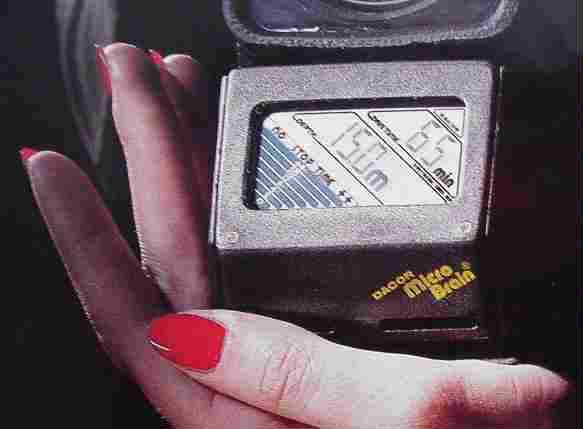
- it had the next program version, the P-4 built in,
- with full decompression prognosis
- and a non-volatile storage (EEPROM) which recorded for the complete life-time of the box:
- # of dives, complete duration of all dives and maximum depth
- once i tested it in the Red Sea, at a place called TOWER
- I went down to approx. 110 or so: it didn't give!
- AND: it really showed me reasonable deco-times
- I have a unit in my museum: it is still working, AND:
- I am useing it today (2002)!!! from time to time:
- as a backup on longer divetrips
- or as a reference unit, when I get a new divecomputer for testing/validation
- the little black triangle displayed dynamically the remaining NDL
- or the complete time-to-surface resp. the deco-times
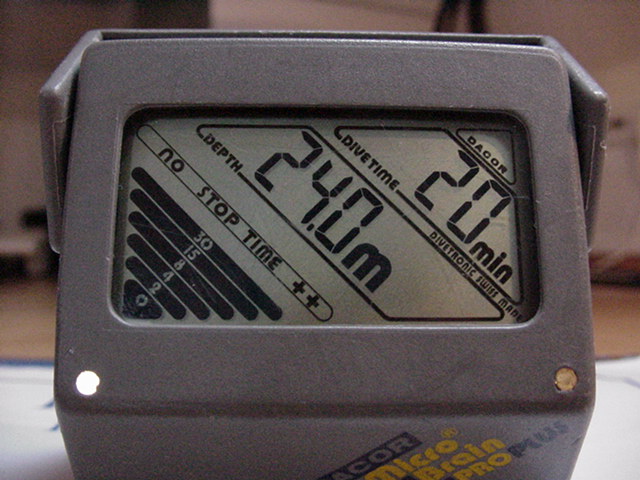
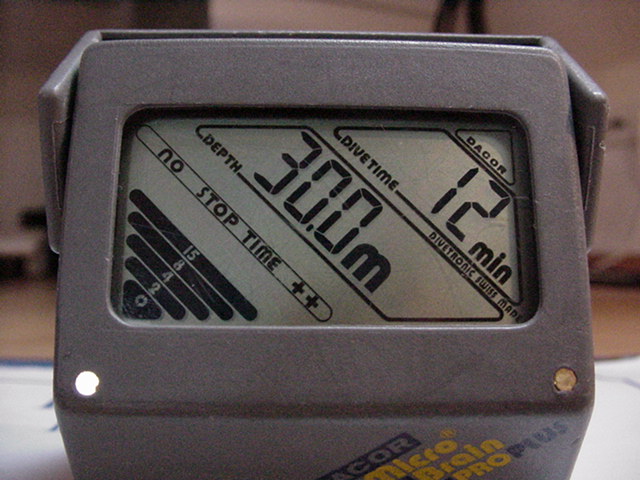
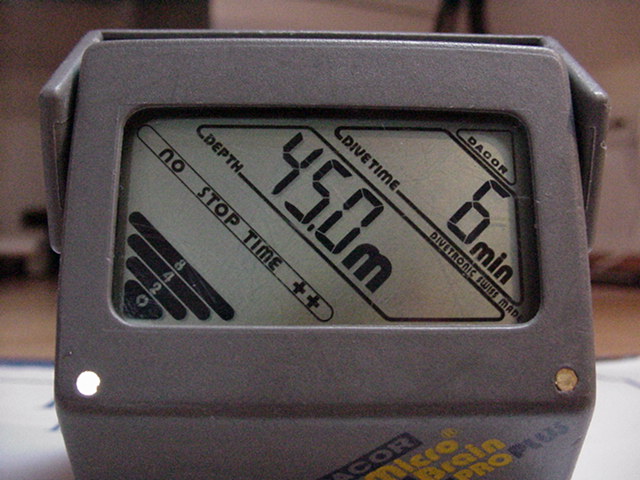
- the design was anatomique, right hand side is the magnet to switch the unit off!

Info Flyer
1993: MC 36 / OCEAN EDGE (San Diego, Calfornia)
part of the manual, german
1994: Aladin AIR X / UWATEC
the press announcements at the fair: boot '94 (german)
info from UWATEC concerning ZH-L 8 ADT (german)
the whitepaper from UWATEC (german)
Pictures from the UWATEC ALADIN AIR X O2
- this one is an air-integrated SCUBAPRO Model
- called TRAC which stands for: Time Remaining Air Computer
- it featured the software version P-6
- it was as well a software modification of the famous ZH-L 16 system:
- with 9 compartments and halftimes from 5 to 700 minutes
- bubble reduction came for dives deeper than 50 with a little penalty in the deco-time and as well
for repetitive dives and for reversed profiles
- the name TRAC is, when you pronounce it with a heavy swaebian accent something like: dirt or rubbish, well:
- in fact, once I made a dive to the wreck ANNA at Mykonos/GREECE, suddenly, in the middle of the dive
after 30 min. at 30 m., the display showed:
- 0 m., 0 min., 0 Bar
- I felt a little bit unhappy after a couple of minutes and finally quit the dive
- nevertheless I used it again until the next failure of that kind, then decided to never use it again!
- the display was great and easily readable:

- here we have a machine from AQUA-LUNG / US DIVERS
- it is one of the famous MONITORs: the MONITOR 2
- it uses more or less only a slightly modified BUEHLMANN model for decompression with coefficients from 1983
- it used only 6 compartments with halftimes from 6 to 320 minutes

- now here we have the ALADIN PRO from Uwatec
- with enhanced battery compartment
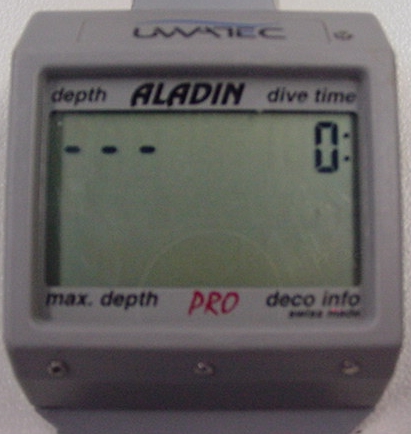
- in the meantime it was 1997
- and SCUBAPRO bought UWATEC
- here we see the SCUBAPRO
- Model DC 12
- it uses also the well-known software version P-6
- but it used only 6 compartments
- with silent bubble reduction
- in dependance of total ascent-time (the sum of all deco-times) and ascent speed!
- for example: if total-ascent time was more than 30 min., you got extra deco-times at 3 m.
- well, there have been massive problems with the piezo, and I used them in "Six Pack" quantities ...
- hmmm: have a look at my last remark and the picture at the very end of this file ...
- following is a comparison of the No Decompression Limits (NDL) in minutes between the P-4 (MicroBrain) and P-6 (DC12):
Tiefe
m |
Depth
feet |
Nullzeiten
NDL
Micro Brain P-4
Minuten |
Nullzeiten
NDL
DC12 P-6
Minuten |
|
| 12 |
40 |
106 |
99 |
|
| 15 |
50 |
64 |
59 |
|
| 18 |
60 |
44 |
37 |
|
| 21 |
70 |
31 |
26 |
|
| 24 |
80 |
20 |
20 |
|
| 27 |
90 |
15 |
16 |
|
| 30 |
100 |
12 |
13 |
|
| 33 |
110 |
10 |
11 |
|
| 36 |
120 |
8 |
10 |
|
| 39 |
130 |
7 |
9 |
|
| 42 |
140 |
7 |
8 |
|
| 45 |
150 |
6 |
7 |
|

as well we have a look here in to the decompression model:
from the DC 12 manual (german)
- then we have the SCUBAPRO / UWATEC ALADIN PRO ULTRA
- ca. 2000 / 2001: it features the ZH-L8 ADT which means
- 8 compartments with an adaptive feature (ADT) to cold and strenous dives
- the ascent rate drops to 7 m / min near the surface
- as well NITROX from 22 to 50 % Oxygen

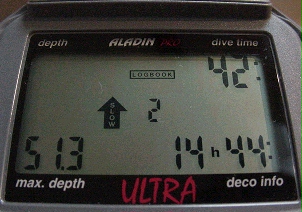
- next comes an OCEANIC computer: the VersaPro
- according to handbook, there should be a Powell-Rogers (DSAT) Model
- Nitrox from 21 bis 50 %
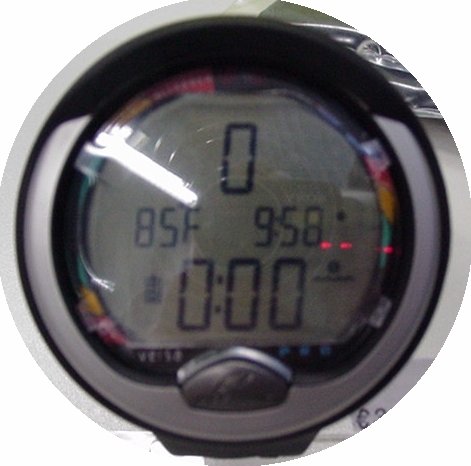
- in 2001 I joined an end-consumer evaluation test and tried it thoroughly on the Maledives
- by transcending the DSAT Model limits there is a cryptic change to U.S.N parameters
- a little dive to 31 m and 30 min. resulted in a 11 min. deco stop!
- the "real" U.S.N wants only 3 min. stop for it, so I tried to figure out, how this is done
- when it comes to repetitive dives, a somewhat unpredictible behavior starts (well, fortunately I had my DC-12 as a back-up with me!)
- but neither the german distributor nor the american developers could tell me, how the algorithm should work
- well, exactly for this reason, I could recommend this thing only for holiday/hobby divers
- the use for semi-professionals (Dive Masters, Assistant Instructors) or for real Instructors is strongly
discouraged ...
- and here we have it, operating since ca. 1999 still up to now (2009):
- the SCAN 4 from U.S. Divers
- air integration

- as well with the DSAT algorithm
- changing the battery is easy
- a nice, easy-to-read display
- the traffic-light graphs for the compartment saturation, the deco stops and the ascent speed:

- but with a really silly time-to-fly display:
- always 24 h, no question how short or shallow the dive was ...
- but normally quite reliable, it just quits only every 20 dives ...
back to: Contents
back to: DIVE TABLES homepage
















